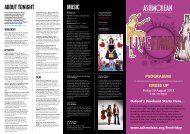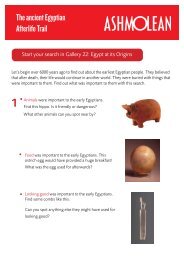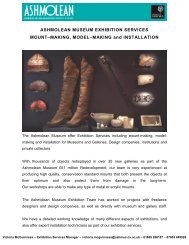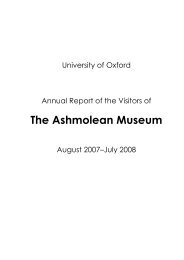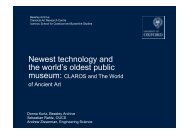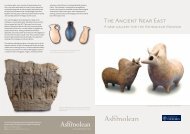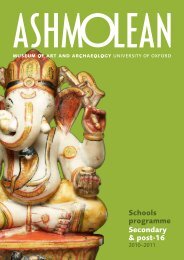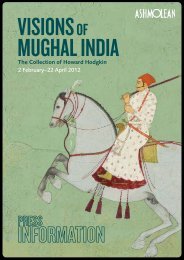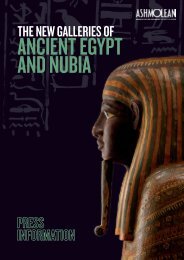1 Italian Maiolica of the Renaissance - The Ashmolean Museum
1 Italian Maiolica of the Renaissance - The Ashmolean Museum
1 Italian Maiolica of the Renaissance - The Ashmolean Museum
Create successful ePaper yourself
Turn your PDF publications into a flip-book with our unique Google optimized e-Paper software.
catalogue <strong>of</strong> that collection, edited by Timothy Wilson and Elisa Paola Sani (2007), no. 91.<br />
p. 32, no. 11 was acquired by <strong>the</strong> Fondazione Cassa di Risparmio di Perugia in 2006 (see<br />
introductory note) and is republished by Wilson and Sani 2006, no. 6.<br />
<strong>The</strong> correct transcription <strong>of</strong> <strong>the</strong> inscription is ell[e].d[e].sebeste.s.<br />
This albarello was lot 77 at So<strong>the</strong>by's, London, 20 November 1962.<br />
No. 12 was acquired by <strong>the</strong> Fondazione Cassa di Risparmio di Perugia in 2006 (see introductory<br />
note) and is republished by Wilson and Sani 2006, no. 7.<br />
<strong>The</strong> photograph <strong>of</strong> <strong>the</strong> scratch-marks beneath <strong>the</strong> base has been omitted.<br />
This albarello was lot 76 at So<strong>the</strong>by's, London, 20 November 1962.<br />
p. 36: An important contribution to <strong>the</strong> study <strong>of</strong> Deruta pottery is G. Busti and F. Cocchi, Museo<br />
Regionale della Ceramica di Deruta. Ceramiche policrome, a lustro, e terrecotte di Deruta dei<br />
secoli XV e XVI, Perugia/Milan 1999.<br />
Nos 13-14: Photographs <strong>of</strong> <strong>the</strong> scratch-marks beneath <strong>the</strong> base have been omitted.<br />
No. 13 has now been acquired for <strong>the</strong> Museo Regionale della Ceramica, Deruta; see G. Busti<br />
and F. Cocchi (eds), La ceramica umbra al tempo di Perugino, exhib. cat., Deruta, 2004, no.<br />
14, with tentative attribution to <strong>the</strong> Masci workshop, Deruta. No. 14 is now in a private<br />
collection in France.<br />
I owe to <strong>the</strong> late Giuseppe Maria Nardelli <strong>the</strong> suggestion (and his permission to cite it in <strong>the</strong><br />
Burlington Magazine, 144, June 2002, p. 362) that <strong>the</strong>se jars were made for <strong>the</strong> pharmacy <strong>of</strong> <strong>the</strong><br />
heirs <strong>of</strong> Mariano del Moro at <strong>the</strong> sign <strong>of</strong> <strong>the</strong> Moor’s head in Perugia (cf. G.M. Nardelli,<br />
Farmacie e farmacisti in Umbria, Perugia, 1998, p. 115; see also Wilson in Burlington<br />
Magazine, June 2002). A different interpretation is given by A. Piccini, “La farmacia di<br />
`Almoro’”, Fimantiquari Arte Viva no. 28-9 (2002), pp. 20-6, suggesting that <strong>the</strong> series was<br />
made for a pharmacy in Rome in memory <strong>of</strong> Barbaro Ermolao, Patriarch <strong>of</strong> Aquileia (1453-<br />
93); Piccini interprets <strong>the</strong> arms on <strong>the</strong> British <strong>Museum</strong> spouted jar with lustre as those <strong>of</strong> <strong>the</strong><br />
Frangipane family, whom he suggests as possible commissioners <strong>of</strong> <strong>the</strong> set. A spouted jar <strong>of</strong><br />
spherical body, with <strong>the</strong> moor’s head, was submitted for sale at So<strong>the</strong>by’s in late 2003.<br />
p. 39, note 1: Two more albarellos from <strong>the</strong> "sun" series are in <strong>the</strong> Museo Nazionale della<br />
Ceramica Duca di Martina, Naples, inv. nos 833, 837; see Luciana Arbace, Museo della<br />
Ceramica Duca di Martina: la maiolica italiana (Naples 1996), nos. 38, 39. A bottle was sold<br />
at So<strong>the</strong>by's, 21 October 1980, lot 144. Ano<strong>the</strong>r spouted jar and two undated albarellos were<br />
sold (alongside <strong>the</strong> spouted jar which was later in <strong>the</strong> Sackler collection) at So<strong>the</strong>by's, London,<br />
20 November 1962, lots 66, 67; <strong>the</strong> spouted jar is now in an English private collection. Two<br />
more spouted jars in <strong>the</strong> possession <strong>of</strong> J.M. Béalu et fils were illustrated in CeramicAntica anno<br />
10, no. 8 (September 2000), p. 15. See also C. Ravanelli Guidotti in CeramicAntica anno XIII,<br />
no. 8 (September 2003), pp. 56-7.<br />
p. 42, note 10: For o<strong>the</strong>r moor's head jars presumably later than <strong>the</strong> 1501-2 group, see Luciana<br />
Arbace, Museo della Ceramica Duca di Martina: la maiolica italiana (Naples 1996), no. 20.<br />
p. 42, note 12: <strong>The</strong> summary given here <strong>of</strong> <strong>the</strong> document published by De-Mauri is misleading.<br />
<strong>The</strong> document, <strong>of</strong> 1521, records <strong>the</strong> confraternity <strong>of</strong> Sant' Antonio in Deruta agreeing to give<br />
4




